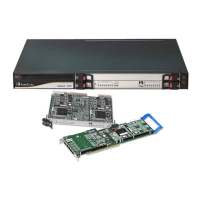Version 5.2 365 September 2007
SIP User's Manual 8. Networking Capabilities
8 Networking Capabilities
8.1 Ethernet Interface Configuration
The Ethernet connection mode can be controlled by using the ini file parameter
EthernetPhyConfiguration to configure one of the following modes:
Manual modes (10 Base-T Half-Duplex, 10 Base-T Full-Duplex, 100 Base-TX Half-
Duplex, 100 Base-TX Full-Duplex)
Auto-Negotiate mode
Auto-Negotiation falls back to Half-Duplex mode when the opposite port is not Auto-
Negotiate, but the speed (i.e., 10/100 Base-T) in this mode is always configured correctly.
Note that configuring the gateway to Auto-Negotiate mode while the opposite port is set
manually to Full-Duplex (either 10 Base-Tor 100 Base-T) is invalid (as it causes the
gateway to fall back to Half-Duplex mode while the opposite port is Full-Duplex). It's also
invalid to set the gateway to one of the manual modes while the opposite port is either
Auto-Negotiate or not exactly matching (both in speed and in duplex mode). It's
recommended to always prefer Full-Duplex connections to Half-Duplex ones and 100
Base-TX to 10 Base-T (due to the larger bandwidth). It's also strongly recommended to use
the same mode in both link partners. Any mismatch configuration can yield unexpected
functioning of the Ethernet connection.
Note that when remote configuration is performed, the gateway should be in the correct
Ethernet setting prior to the time this parameter takes effect. When, for example, the
gateway is configured using BootP/TFTP, the gateway must perform many Ethernet-based
transactions prior to reading the ini file containing this gateway configuration parameter.
To resolve this problem, the gateway always uses the last Ethernet setup mode configured.
In this way, if you want to configure the gateway to operate in a new network environment
in which the current Ethernet setting of the gateway is invalid, you should first modify this
parameter in the current network so that the new setting holds next time the gateway is
restarted. After reconfiguration has completed, connect the gateway to the new network
and restart it. As a result, the remote configuration process that takes place in the new
network uses a valid Ethernet configuration.
8.2 Ethernet Interface Redundancy
The gateway supports a redundancy scheme, as described below:
At the beginning of the start-up procedure, the gateway tests whether the ‘primary’
Ethernet interface is connected, by checking the existence of the Ethernet link carrier. If it's
connected, the start-up procedure commences as usual. If not, the start-up application tries
the ‘secondary’ Ethernet interface. If this interface is connected, the whole start-up
procedure is performed using it. If both interfaces are not connected, the start-up
procedure commences using the parameters, tables, and software residing on the
gateway's non-volatile memory. Note that Ethernet switchover occurs only once during the
start-up procedure (at the beginning). If the Ethernet interface fails after the selection is
made, the gateway does not switch over to the second port.

